The Best Shoot ‘Em Ups of 2022
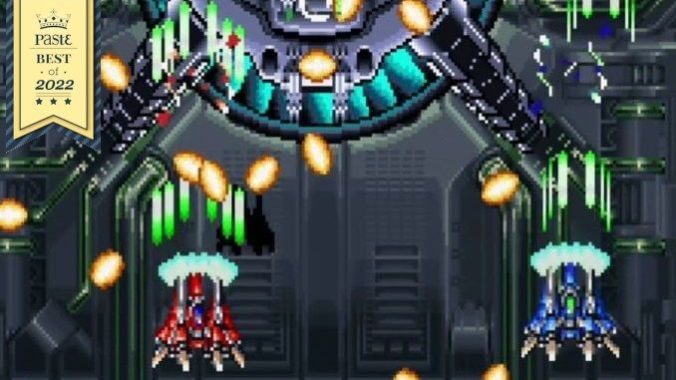
While you’re unlikely to find any of 2022’s shoot-em-ups—shmups, STGs, whatever you want to call them— on many Game of the Year lists, this last year still had plenty of them to offer. Thanks to a combination of brand new games, first-time worldwide releases, console debuts, and re-releases of classics that haven’t been easily available for decades now, 2022 ended up being a memorable year for the ever-iterating genre. Here’s the best of the bunch.
Drainus
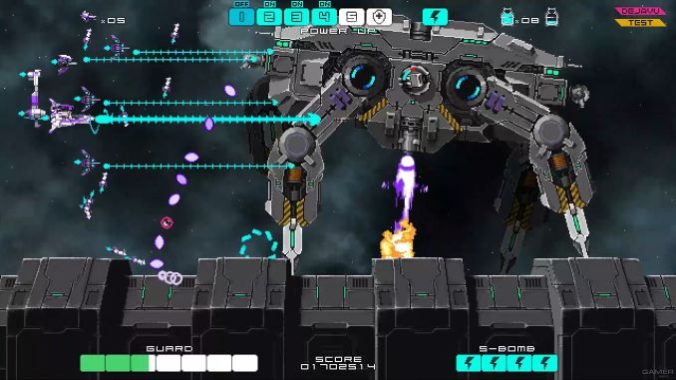
Developer: Team Ladybug
Platforms: Nintendo Switch, Windows
Drainus is the one shoot-em-up from 2022 that broke out of the STG bubble and into the mainstream even a little bit, and not just because of its unfortunate name. Team Ladybug’s debut horizontal shooter is a lovely game to look at due to its animations and art direction, and is an engaging STG, to boot. Though not particularly difficult, especially in comparison to some other ‘22 releases, Drainus scratches other itches. You can continually upgrade your ship and customize the order that specific weapons will be available based on the power-ups you pick up, and narratively, it has cutscenes, characters, and a twist!
Speaking of twists, Drainus is that rare breed of shoot-em-up where you want the bullets to hit you. Well, so long as you’re using the absorbing capabilities of your ship, anyway—then you can unleash a powerful blast back at the foes on your screen. It’s not a new concept, by any means—Treasure helped subvert that expectation decades ago now—but the way Drainus implements it in conjunction with the rest of the package, makes for a memorable STG you’ll find yourself returning to even without the allure of the online leaderboards.
Sol Cresta
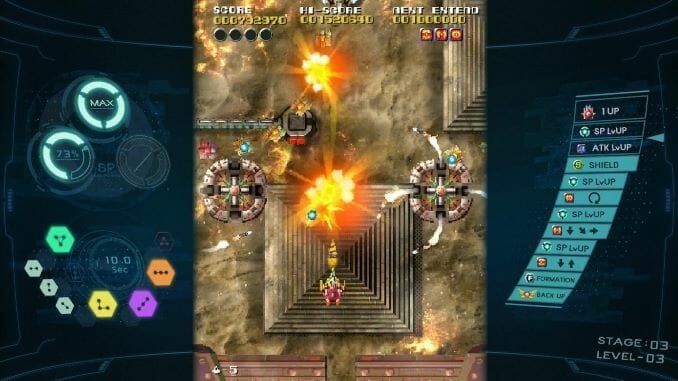
Developer: PlatinumGames
Platforms: Nintendo Switch, Windows
Whereas Drainus was designed to open itself up to a potentially larger audience than your average shmup, Sol Cresta is… not. It was never going to be a critical darling or have mass appeal, but it succeeded in its particular mission to modernize some portions of a 1980s shooter concept. Luckily, the said concept was pretty ahead of its time when unveiled, so while Sol Cresta might feel and look old in many respects, like Terra Cresta before it, it’s still plenty of fun to play if you’re into more old-school STGs.
The beauty of Sol Cresta is in its many layers. Like with Platinum’s action games, you’ll want to start on Easy to get a sense of things, and then replay on progressively tougher difficulties as you begin to master its various quirks and challenges. You upgrade your ship mid-stage utilizing various power-ups, which don’t just impact a single ship but instead a formation of three that you construct and control. Each ship has its own offensive strengths, meaning you need to switch to the correct configuration against the enemies and obstacles weakest to them. These offensive formations are created by collecting icons throughout each stage, and if you get them all, you get to transform into a flaming phoenix that’s impervious to damage. So, not your standard shooter, no.
That said, you should be warned that the game is ugly to look at, and the scanline option doesn’t help either. But hey, at least it’s scored by Yuzo Koshiro, whose effort more than lived up to the franchise’s musical legacy.
Moon Dancer
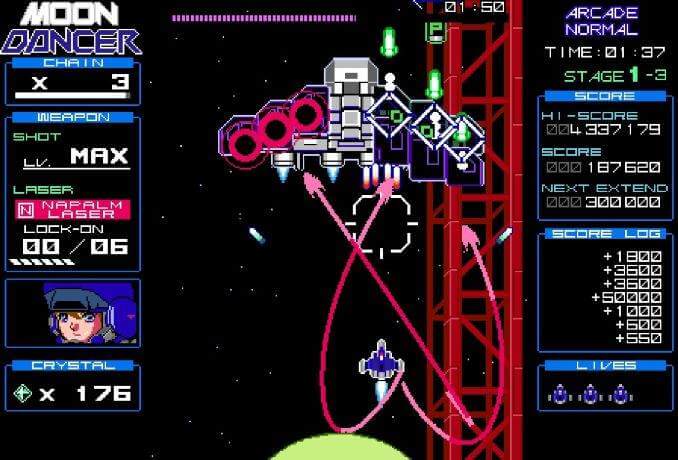
Developer: Terarin Games
Platforms: Nintendo Switch, Windows
Terarin Games is a one-person studio, and they make shmups. The vertically oriented Moon Dancer is the latest of those, and it combines the Compile-style look and shooting seen in Terarin’s 2021 release, Raging Blasters, with a new wrinkle: your ship has a reticule that locks on to enemy vehicles for homing blasts, in addition to your standard, multidirectional blaster.
That itself is an old concept, one derived from 1982’s Xevious and enhanced in 1994’s RayForce, but seeing it in this style of shoot-em-up is a rarity. And unlike those classics, in Moon Dancer, your homing laser is customizable. There’s the default Spear Laser that sends out up to 10 fast-moving lock-on blasts at once, the Napalm Laser that fires just six rounds at a time but also does targeted burn damage, and the Multi Laser, which makes a large space around your ship into an automatic aiming reticule, so you can catch more targets in your sights with less effort. You’ll find uses for all of them.
Moon Dancer is a dose of nostalgia, sure, but it’s not just that by any means. Terarin’s games are more homage to a golden age than anything, with a clear understanding of the material that inspired them, and the ability to weave these different sources together into something new. And modern touches in scoring, online leaderboards, and caravan modes make them much more than just a look back at a different time for STGs.
Eschatos
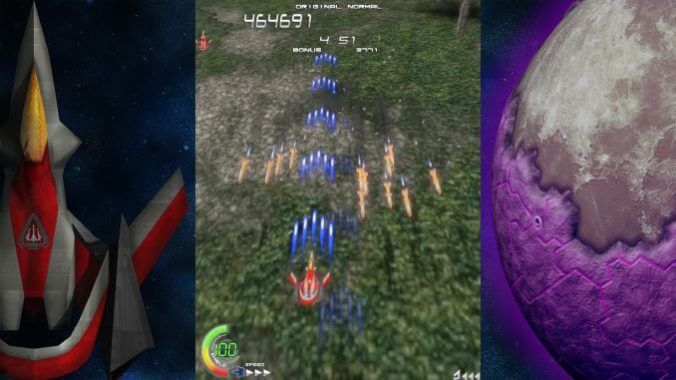
Developer: Qute
Platforms: Nintendo Switch, Playstation 4, Windows
Eschatos isn’t new to North America, as it’s been available on Windows for years, but it is new to North American consoles in 2022: Qute’s fantastic vertical shmup was one of many Japan-exclusive Xbox 360 games released at a time when Microsoft really wanted things to work out in Japan.
Eschatos is simple to figure out and difficult to master. At its most basic, all you do is shoot, dodge, and shield. Shooting is rapid-fire, whether you’re using the forward shot that stretches out beyond the screen, or the wide shot that lacks range, but allows you to catch stragglers coming from an angle. And that’s important in Eschatos, as the scoring multipliers are based around successfully wiping out entire waves of enemies: clear one wave, and you get a 2x multiplier; do it to the next wave, and it’s 3x, and so on. Fail to get rid of a wave and your multiplier is wiped out, which means if you lose it, you’re potentially giving up a ton of points per ship.
You don’t have a bomb, but every now and again a little power-up labeled “F” can be grabbed and will clear the screen of foes, which if timed right, can save you from losing a multiplier. Your shield is both an offensive and defensive tool, and you can crash into smaller foes or brave enemy lasers so long as it’s up. Unlike your forward and wide shots, though, your shield is limited use.
Eschatos is TATE-enabled, comes with the original mode, an arrange mode that includes power-ups, and a Time Attack, as well as an optional remastered version of the original score. Eschatos is certainly worth the price of admission alone, but it comes packaged with a pair of Bandai WonderSwan Qute shmups as well: Judgment Silversword and Cardinal Sins.
Layer Section & Galactic Attack S-Tribute
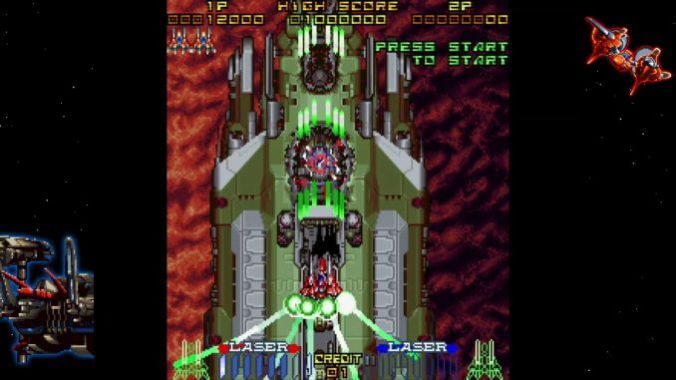
Developer: Taito/City Connection
Platforms: Nintendo Switch, Playstation 4, Xbox One, Windows
RayForce got a mention earlier, and if you didn’t already know, that’s simply the arcade name for the console shmup Layer Section, which in Europe is called Galactic Attack, unless you were in a European arcade, in which case it was called Gunlock. Layer Section, at least, gets at what you’re doing in the game, since you use a lock-on laser to target the foes in the layers of game world beneath your ship, while firing rapid-fire shots at the enemies in front of you. The more enemies you target and destroy at once, the larger the score bonus, and also the longer you’ll manage to survive this descent into Earth’s mechanized core.
Honestly, there isn’t much shiny or new in Layer Section & Galactic Attack S-Tribute, but that’s fine, because the original is an all-timer in the genre that hasn’t been readily available outside of iOS or Android for ages. The original console conversion was on the Sega Saturn, and its initial Windows release came in 1997. It was included in Taito Legends 2 on the Playstation 2, Xbox, and Windows in 2007, but due to technical issues it was an inferior way to experience the beautiful, high-speed 32-bit shooter, and it’s not like they produced many of those discs to begin with.
Now, though, it once again looks and plays like it should. RayForce is on Taito’s Egret Mini II as well, which also released in 2022, but it’ll be far less expensive for you to just grab one of the console versions if it’s all you’re interested in.
Cotton Fantasy: Superlative Night Dreams

Developer: Studio Saizensen
Platforms: Nintendo Switch, Playstation 4
Cotton games have a cuteness to them that belies their difficulty, and Cotton Fantasy is no exception. The first brand new Cotton title since 2000’s Japan-only Dreamcast outing, Rainbow Cotton, Cotton Fantasy comes on the heels of 2021’s Cotton Reboot! and its own S-Tribute release, Cotton Guardian Force. After literal decades without any Cotton, suddenly we’re awash in it.
Cotton Fantasy, developed by Studio Saizensen of Umihara Kuwase fame, isn’t going to convert any non-believers to the series or STGs in general, but the horizontal cute-em-up is well worth the time to anyone who has already bought into either. The big draw here is a scoring system that, if mastered, will result in an endless loop of huge point gains, but you have to live long enough to reap the benefits. That’s always the rub, and the desire to get those big multiplier payoffs might also be your undoing in the staying alive department, too.
You have your pick of characters, all with little differences, but the basic setup is the same: collect different colored jewels to unlock various attacks, use up those jewels with a brief special attack that converts enemies and bullets into point-multiplying collectibles, try to get said multiplier all the way up to 99x, and then rinse and repeat as long as possible to keep the points coming in. If your goal is just to muscle through the main game with continues, Cotton Fantasy won’t seem particularly fun or special. But if your goal is to one-credit clear it all while trying to crack the upper portion of the leaderboards, you’re going to love what it has to offer.
Sophstar

Developer: Banana Bytes
Platforms: Nintendo Switch, Windows
My only real complaint with Sophstar is that it takes too long for one of the things that sets it apart from other shooters to really come into play—the teleportation mechanic. Before then, it feels like any other vertical shoot-em-up, granted a really good one of those. Sophstar has all the ships to choose from you could want, each with their own wrinkles and abilities, and a scoring system that will hook you. It has no shortage of difficulty levels for its main eight-stage campaign, features 60 “Cadet School” stages that, despite the name, are more challenge than tutorial, and an array of modes including Endless, Timed Challenge, and Score Attack.
The scoring system, though. The first part of it keeps you feeling tense, as it’s a multiplier that goes up to 9x, and is dependent on how often and how recently you’ve downed an enemy ship. The bigger part of things, though, is that each defeated ship drops a scoring chip, which is worth just 100 points. Except, that amount gets smaller the longer the chip is on screen, and its point total can be increased by your multiplier, so… if you decide to do the perilous thing and live up near the top of the screen, you can grab 900-point chip after chip. Or, you know, die a lot. That’s why it’s a risky maneuver!
The first stage or so is pretty standard fare, scoring aside, but each subsequent one ramps up the intensity, and makes the tasks of dodging bullets and collecting scoring chips difficult to manage at the same time. However, in order to earn more lives and post a high score, that’s just what you’re going to have to do. Sophstar has just enough “one more play” in it to make that work.
Gunvein
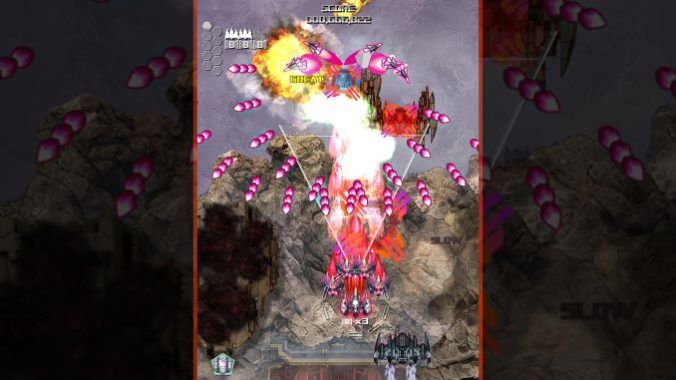
Developer: NGDEV
Platform: Windows
NGDEV got their start in the retro homebrew scene developing games for the Dreamcast and Neo Geo well past the market’s sell-by date on either console, but they’ve since moved into producing titles for modern platforms. Gunvein is difficult, but that’s the appeal: it’s one of the most Cave-like STGs from a non-Cave developer, in terms of how it is simply unafraid to throw wave after wave of bullets your way, forcing endless movement. Unlike some bullet hell games, however, Gunvein wants to help you understand what you’re doing, what is being done to you, and how you can avoid the worst of it. The tutorial explains the different kinds of waves of bullets, how to avoid them, and how to manipulate them so they’re coming for where you were instead of where you are or are going. It might be old news for vets, but not everyone is on an STG message board or has the experience to know these tips already, and it’s good to see it spelled out, especially when attached to a game that will challenge anyone who picks it up.
What makes Gunvein stand out from other bullet hell options is its focus on bombing opponents. Bombs are a last resort to avoid death in most shooters, the thing you have few of and that you sometimes earn massive point bonuses for not using. That’s been true since screen-clearing bombs were first popularized in 1985’s Tiger-Heli. By contrast, in Gunvein, bombs are your path to a high score: you earn bomb fragments for defeating enemies quickly, and once you have enough fragments, you earn a whole bomb. Use a bomb to defeat even more enemies, and pull in huge gold stars worth tons of points while setting up to collect more bomb fragments to get more bombs, and so on. To down enemies fast enough to earn bomb fragments, you’ll have to utilize both your standard shots, as well as lock-on homing blasts. There are three ships to choose from, all with their own style of forward shot, lock-on range, and ship speed, so you have all kinds of preference stuff to work out in addition to figuring out how best to approach… everything.
Gunvein has its standard mode, which requires you to complete additional missions and challenges in order to earn more continues, and comes with its own nifty wrinkle: if you decide to continue your game rather than upload your score, your points are converted to in-game currency, which can be used to buy additional lives, bombs, continues, or even a one-hit shield for your next run. There’s also those challenge missions, as well as a randomized roguelike arrangement that basically spits in the face of trying to figure out how the more structured version of the game works.
It’s a Windows exclusive for now, but Gunvein was also announced for the Switch, Playstation 4, and Xbox One. The wait will be worth it.
Those are the big ones, but there’s more where that came from.
Toaplan Arcade Garage: Hishou Same! Same! Same!: The second of M2’s ShotTriggers series that focuses on Toaplan classics, you’ll need to either import a physical copy of the game from Japan, or download it on the Switch or Playstation 4 digital shops. As has already been noted once this year here, you should.
Tukiyono: A free-to-play (but actually free) horizontal bullet hell shmup. You can slow down time to absorb enemy bullets and missiles, and then fire them back as a giant, high-damage ball. However, you’re limited in how often you can use this skill, and have to replenish its meter by blowing up enemies and collecting the green orbs they drop. It’s available to download for Windows, but can also be played right in your browser. Real easy to get sucked into, and tempting to 1CC.
Metal Black: Metal Black is by no means new, but, like RayForce, this Taito classic vanished after it was ported to the Saturn until it was included in Taito Legends 2. It’s part of the Arcade Archives series as of November 2022, meaning you don’t need an Egret Mini II in order to experience this highly influential shmup. Do you like the enormous countering beam system from G-Darius? You’ll be into Metal Black.
Orius: Another Arcade Archives release, except this one arrived at the end of 2021—it counts, everyone is done announcing their games of the year by then. Orius (or Xexex, depending on where you live) is a horizontal Konami shooter from 1991 that pushed 16-bit arcade tech in such a way that it never received a console port to any of those systems. You should play the Japanese version: don’t worry, both are included in the Arcade Archives release.
Deathsmiles II: Another post-GOTY 2021 release, Deathsmiles II was originally only available in an unlocalized digital form on the North American Xbox 360. After it was packaged with the original Deathsmiles last winter, though, it’s now available basically everywhere and localized, too. Rather than sprites, it was the first Cave shooter to use polygons, but they looked behind the times when they released, never mind now. Otherwise, though, it’s a perfect introductory bullet hell game just like the original, as it’s incredibly forgiving with its hit boxes, and saves its complexity for convoluted scoring systems rather than mere survival.
Marc Normandin covers retro videogames at Retro XP, which you can read for free but support through his Patreon, and can be found on Twitter at @Marc_Normandin.